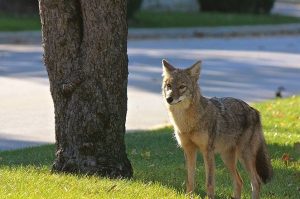County warns about keeping pets safe during coyote mating season
Chronicle Media — April 5, 2021
Coyotes are naturally very shy of human contact, but if you do come across a coyote on a walk wildlife experts say to make yourself very big and loud to scare it away. (Photo courtesy of wildlifeillinois.org)
There have been recent sightings of coyotes around Cook County. The County’s Department of Animal and Rabies Control (ARC) reminds residents that coyote mating and whelping season lasts through May.
During this time, coyotes are establishing territories and dens to whelp their pups. Until weaning, coyotes are more visible and more aggressive. ARC offers the following tips to prevent tragic encounters between coyote and cats or small dogs:
- In areas near heavily wooded parts of Cook County, studies have found that cats can be a substantial part of coyote’s diet. This time of year, it’s essential to keep your cats indoors, especially at night.
- Small dogs are also a food source as well as a perceived threat to coyotes looking after their own pups. This time of year, small dogs should be supervised at all times in the backyard, especially after dark. Barking may also attract coyotes so it’s important to stay alert.
- Switch up your routine. Coyotes are smart and can learn your schedule. If you always let Fido out or take him for a walk at a certain time, coyotes will learn that and be ready at that time.
- Feral cats should be fed during daylight hours and food should never be left out. That can be a welcome invitation for coyotes.
- Walk dogs on a short leash and always be aware of your surroundings.
- Bird feeders attract small mammals looking for food that may have fallen from the feeder. Raking and removing the bird feed from the ground will keep small mammals and coyote from being attracted.
- Most coyotes are naturally very shy of human contact, but if you encounter a coyote on a walk make yourself very big and loud to scare it away. Carrying and using a whistle, bell or horn can help scare them away as well. You can also jump around and bang on garbage cans or whatever is nearby.
The population of coyotes roughly doubles in Cook County during mating and whelping season. By the end of summer, disease and other events brings the population back to its normal size of approximately 2,000.
“The coyote in our area have learned to adapt living closely to people in both the County and the City of Chicago,” said Dr. Tom Wake, administrator of the Cook County Department of Animal and Rabies Control. “If we do our part in allowing them to remain wild they will be a minimal nuisance to us and our pets.”
For more information about the County’s Department of Animal and Rabies Control, please visit: https://www.cookcountyil.gov/agency/animal-and-rabies-control-0







